Halligan (DD-584)
1943–1945
John Halligan Jr. was born in South Boston, Mass., on 14 May 1876 to John and Maggie E. Halligan and was appointed to the U.S. Naval Academy from Massachusetts on 6 September 1894. He played football there all four years, serving as team captain during his first class year. Halligan graduated at the top of his class in 1898.
His initial assignment on 4 April 1898 came to Brooklyn (Armored Cruiser No. 3), flagship of Como. Winfield Scott Schley. Three weeks later, Congress declared war against Spain, beginning the Spanish-American War. Halligan served in Brooklyn during the battle of Santiago, Cuba, on 3 July 1898, for which he was awarded the Special Meritorious Medal, for rescuing Spanish sailors from burning ships. He also served as the boat officer when Brooklyn’s Capt. Francis A. Cook traveled over to the armored cruiser Cristóbal Colón to take her surrender.
Reporting to school ship Santee at the Naval Academy on 23 September 1898, Halligan completed post-graduate training in naval architecture and returned to Brooklyn on 18 May 1899. Beginning in September of that year, he completed several short tours in armed yacht Gloucester (14 September–6 December), Massachusetts (Battleship No. 2) (11 December–6 January 1900), the armed yacht Vixen (10 January–20 February), and New York (Armored Cruiser No. 2) (20 February–29 May). He then transferred to Du Pont (Torpedo Boat No. 7). On 21 June, Halligan was commissioned ensign, to date from 4 April 1900.
Seeing service with the Asiatic Fleet, Halligan reported to Scindia (Collier No. 14) as one of the ship’s watch and division officers on 18 August 1900. He transferred to convoy ship Manila on 11 November and then to gunboat Don Juan de Austria on 1 December. After spending five additional days with Manila, Halligan rejoined the fleet’s new flagship New York on 4 June 1901. Detaching on 30 August, his orders were to proceed home and then report to the Secretary of the Navy. His next assignment took Halligan to Norfolk, Va., on 23 October to work with torpedo boats. In 1902, he married Katrina Hoskinson Loomis, a union that produced a daughter, Katherine, on 25 February 1907.
Advancing to the rank of lieutenant (junior grade) effective 4 April 1903, Halligan arrived at Bridgeport, Conn., on 8 July for duty at the Lake Torpedo Boat Co. On 7 December, he reported to storeship Glacier at Norfolk, detaching upon her decommissioning on 30 July 1904. He then joined the collier Marcellus at Norfolk on her recommissioning on 15 August. On 8 November, he was promoted to lieutenant, to date from 1 January 1904.
Halligan arrived at the Bureau of Ordnance on 9 January 1905, serving there for two and a half years. He then transferred to Nebraska (Battleship No. 14) on 23 September 1907 and became the senior engineer of that ship on 25 November 1908. After joining the Bureau of Steam Engineering at the Navy Department on 12 June 1909, Halligan was sent to Liverpool, England, via Montreal, Canada, in July to study turbine machinery at sites as directed by the bureau. He advanced to the rank of lieutenant commander as of 11 March 1910.
On 19 September 1912, Halligan began a two-year tour as navigator in Wyoming (Battleship No. 32). He became Fleet Engineer, Atlantic Fleet, on 17 September 1914 and assumed additional duty as aide on the personal staff of the Commander in Chief, Atlantic Fleet, in January 1915. Returning to the Naval Academy in September 1915, he served as Head of the Postgraduate Department through March 1917. Shortly before his departure, he was promoted to commander, effective as of 29 August 1916.
In early April 1917 as the U.S. entered the Great War [World War I], Halligan was assigned as an aide to the staff of the Commander Patrol Force, Atlantic Fleet, based in Olympia (Cruiser No. 6). On 8 August, he took over as Chief of Staff, Patrol Force, Atlantic Fleet, now situated in Birmingham (Scout Cruiser No. 2). On 25 October, he assumed duty as Chief of Staff to the Commander U.S. Naval Forces in France, stationed in Prometheus (Repair Ship No. 2). For his service in the latter capacity he was awarded the Distinguished Service Medal. Halligan received a temporary promotion to the rank of captain on 1 July 1918.
With the war in cease fire and awaiting a formal resolution, on 30 January 1919 Halligan reported for duty as Chief of Staff, Commander Squadron 4, Battleship Force, Atlantic Fleet, in flagship New Mexico (Battleship No. 40). Assuming command of Ohio (Battleship No. 12) on 19 May 1919, Halligan also took charge of Coast Battleship No. 4 (ex-Iowa) beginning on 2 August 1920. In this role, Halligan remotely operated the former battleship from the decks of Ohio as part of an experimental project to test the feasibility of using radio-controlled, unmanned ships as targets to better simulate actual battle conditions during gunnery practice exercises.
Halligan’s next assignment brought him back to the U.S. Naval Academy where he served as officer in charge of the Naval Engineering Experimental Station. During his tenure, he achieved the permanent rank of captain on 3 June 1921. Departing on 1 May 1923, Halligan next reported to the Bethlehem Shipbuilding Corp. in Quincy, Mass., for fitting out of the light cruiser Detroit (CL-8). He assumed command of the ship upon her commissioning on 31 July 1923.
Following several months of instruction at the Naval War College, Newport, R.I. (6 July–28 October 1925), on 29 October 1925 Halligan was appointed Chief of the Bureau of Engineering at the Navy Department in Washington, D.C. While serving in this position through 31 August 1928, Halligan also held the title of Engineer in Chief of the Navy with the rank of rear admiral.
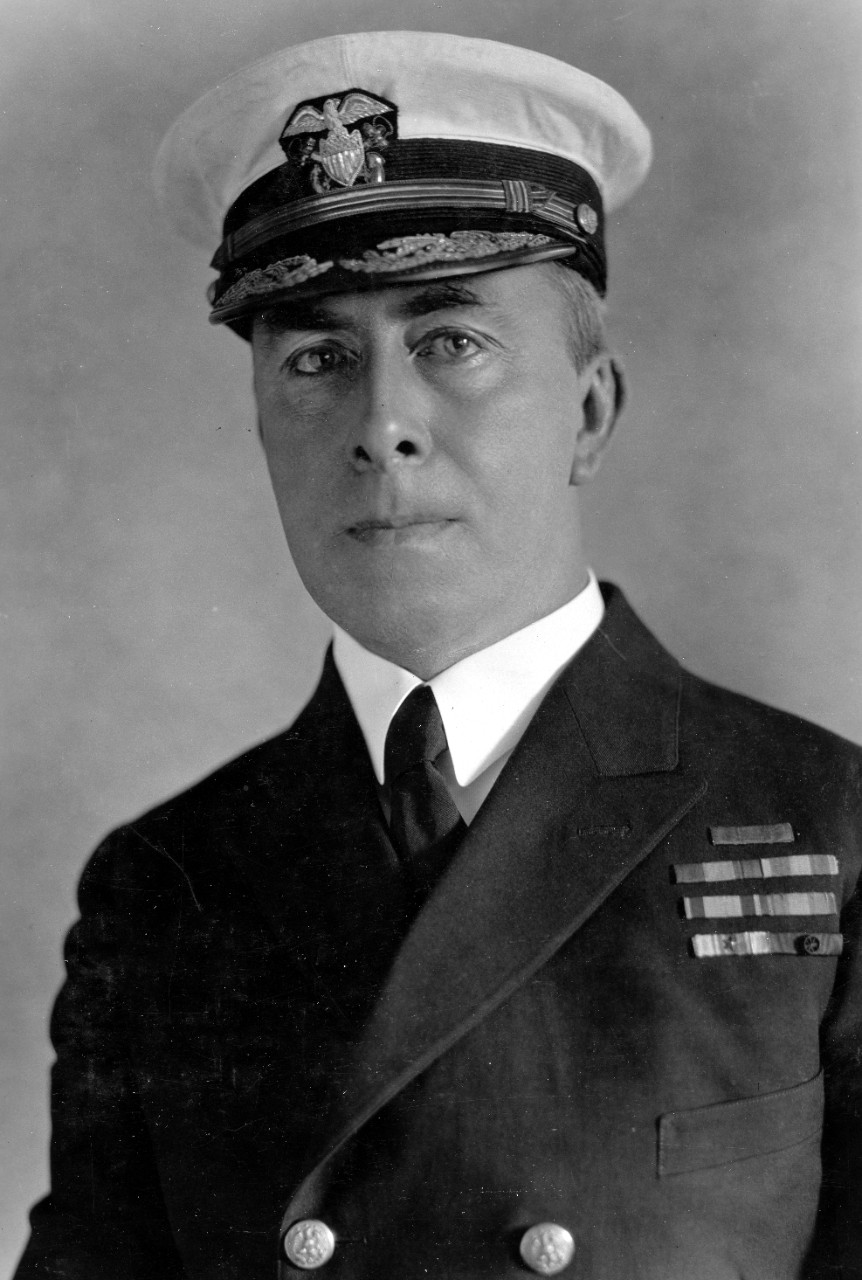
After a brief period of instruction at NAS Pensacola to qualify as a naval aviation observer, Halligan joined aircraft carrier Saratoga (CV-3) as her commanding officer on 15 September 1928. He next became Commander Aircraft Squadrons, Scouting Fleet on 20 April 1929. Promoted to rear admiral on an interim basis on 12 August 1930, his rank became permanent on 3 January 1931. In the meantime, he relieved Rear Adm. William H. Standley as Assistant Chief of Naval Operations on 15 September 1930. After returning to the Naval War College for further instruction (June 1931–May 1932), Halligan served as Commander Aircraft, Scouting Force, hoisting his flag in carrier Lexington (CV-2) on 20 June 1932. With a reorganization of naval aeronautical forces early the next year, his title changed to Commander Aircraft, Base Force, as of 1 April 1933. Then on 10 June, he assumed the role of Commander Aircraft, Battle Force, for a term of one year, taking on additional duties as Commander Aircraft, U.S. Fleet, his flag in Saratoga, on 8 August 1933.
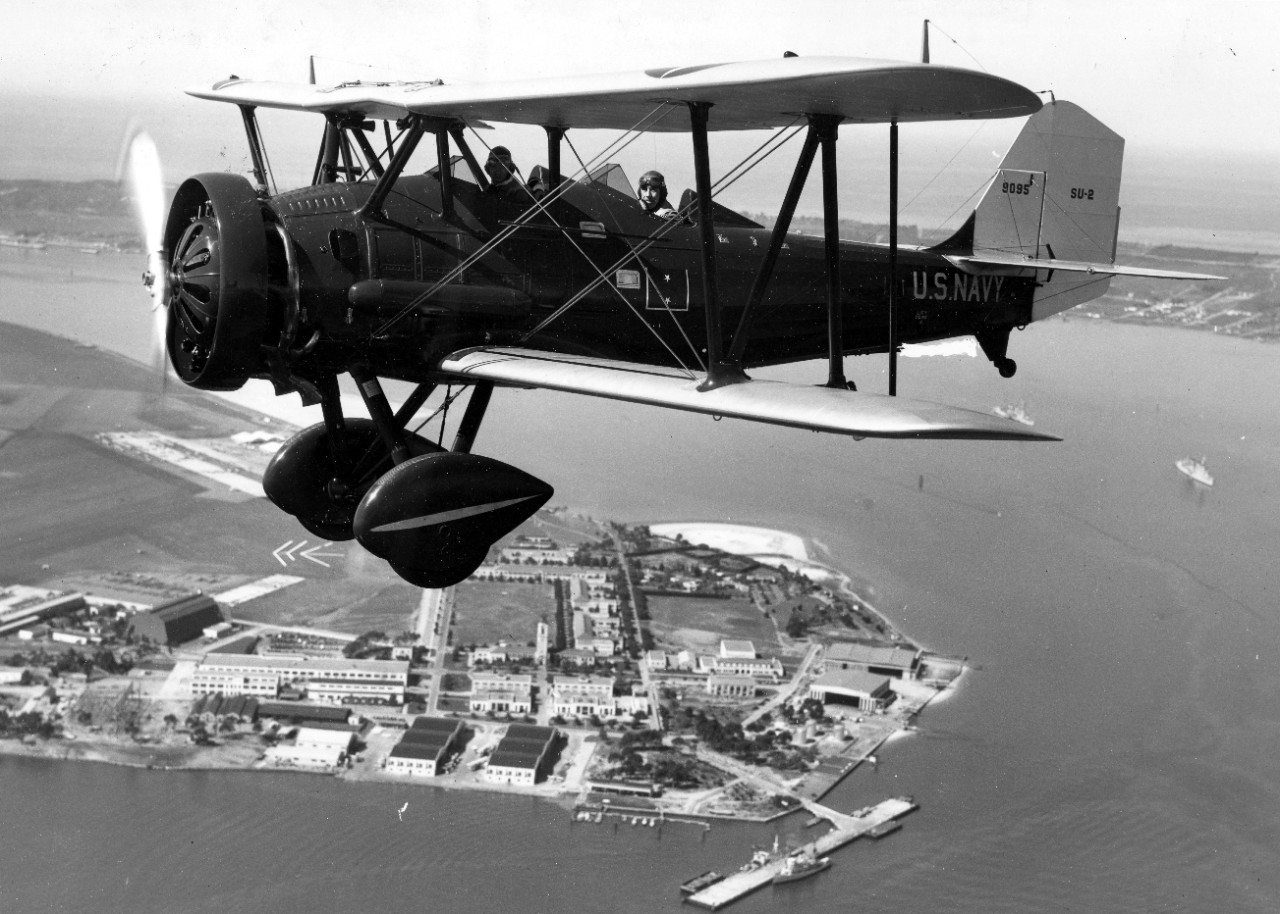
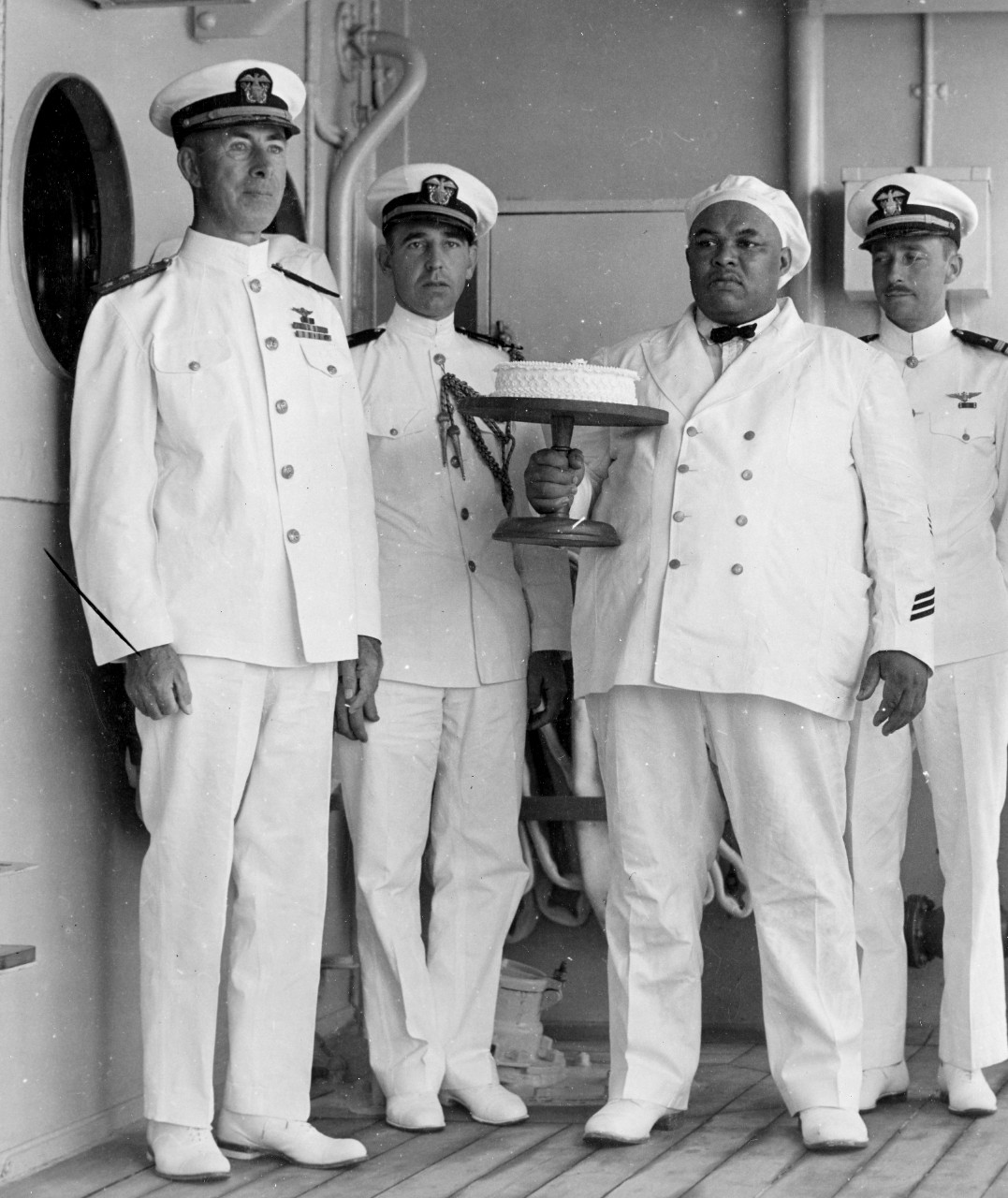
Halligan became Commandant of the Thirteenth Naval District, based in Bremerton, Wash., with additional duties as Commandant of the Puget Sound Navy Yard on 11 July 1934. While serving in this capacity, Halligan passed away at Naval Hospital Puget Sound on 11 December 1934, several days after undergoing emergency surgery for stomach ulcers. He is buried at the U.S. Naval Academy Cemetery.
In addition to the Distinguished Service Medal and Special Meritorious Medal, Rear Adm. Halligan received the Legion of Honor from the government of France. Both the U.S. Naval Academy and the U.S. Naval Postgraduate School (Monterey, Calif.) named buildings in his honor.
(DD-584: displacement 2,050; length 376'6"; beam 39'4"; draft 13'5"; speed 35.5 knots; complement 273; armament 5 5-inch, 10 21-inch torpedo tubes, 4 40-millimeter, 6 20-millimeter, 6 depth charge projectors, 2 depth charge tracks; class Fletcher)
Halligan (DD-584) was laid down on 9 November 1942 at Boston, Mass., by the Boston Navy Yard; launched on 19 March 1943; and sponsored by Mrs. Katrina Loomis Halligan, widow of the ship’s namesake.
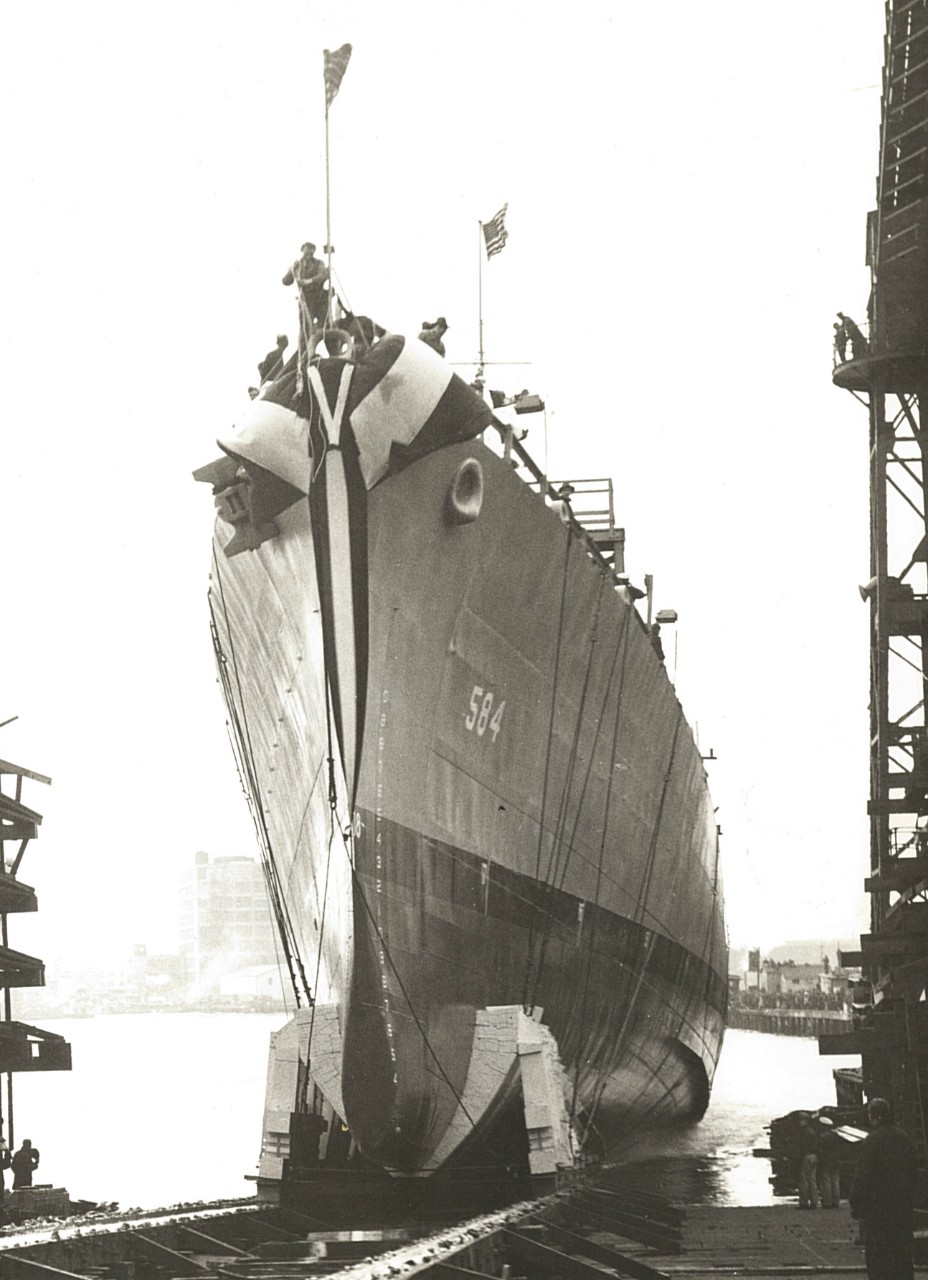
Following her commissioning on 19 August 1943, Cmdr. Clarence E. Cortner in command, Halligan remained at the Boston Navy Yard for fitting out, builder’s trials, and instrument calibration, including a period in dry dock from 26–29 August 1943. On 11 September, the new destroyer departed Boston, steaming independently and arriving at Great Sound, Bermuda, on the afternoon of the 13th. For the next month, the ship engaged in shakedown training with fellow destroyers Gatling (DD-671) and Colahan (DD-658) as part of Task Group (TG) 23.1, the Destroyer-Destroyer Escort Shakedown Task Group. Together and independently, the destroyers practiced skills in essential operational knowledge areas including antisubmarine warfare (ASW), gunnery and fire control, torpedo and depth charge operation, formation maneuvering, battle tactics, engineering casualties, damage control, nighttime operations, and vessel towing.
Early in the training period on the afternoon of 18 September 1943 after returning from radio direction finder calibration, Gatling struck Halligan’s starboard bow while maneuvering to moor alongside, denting the latter’s hull. Then while getting underway the next morning, Colahan collided with Halligan on her port side. As a result, Halligan spent the next three days moored alongside destroyer tender Altair (AD-11) for emergency repairs. A third mishap occurred on 4 October when Colahan’s starboard anchor scraped along several frames of Halligan’s bulwark during a towing exercise.
Upon completion of shakedown training, Halligan sailed for Boston on 16 October 1943, arriving at the navy yard on the afternoon of the 18th to begin post-shakedown availability. The ship returned to dry dock from 20–23 October. After degaussing and calibrating her magnetic compass on 29 October, she steamed independently for Hampton Roads, Va., arriving at Naval Operating Base (NOB) Norfolk on the morning of the 31st. She conducted training in the Chesapeake Bay training area on 2 November, and with the arrival of Hall (DD-583) in port on the 3rd, Halligan reported for duty with Destroyer Squadron (DesRon) 51, Destroyer Division (DesDiv) 101.
On 5 November 1943, Halligan, Hall, and Macomb (DD-458) steamed for Bermuda, arriving at Port Royal Bay on the 7th. There they completed gunnery exercises and upkeep until the 13th, when the destroyers departed to rendezvous with the battleship Iowa (BB-61), transporting President Franklin D. Roosevelt and other U. S. officials across the Atlantic to attend the historic Tehran Conference for discussions with the remaining “Big Three” Allied leaders, Prime Minister Winston Churchill of Great Britain and Soviet Premier Joseph Stalin. The destroyers screened the battleship from 15–17 November and then sailed for Horta on the island of Fayal in the Azores. After refueling, they set off again en route to Casablanca, Morocco. Their orders changed, however, and the ships proceeded instead to Freetown, Sierra Leone. Arriving on the 24th, the trio conducted upkeep and gunnery exercises through the 29th.
At 2327 on the night of 29 November 1943, the German submarine U-68 (Oberleutnant Albert Lauzemis, commanding) sank the French cargo ship Fort de Vaux with two torpedoes off the coast of Sierra Leone approximately 120 miles south of Freetown. Early on the morning of the 30th, Halligan, Hall, and Macomb were dispatched to the area to hunt for the enemy. Searching until the early morning hours of 3 December, the destroyers did not make any undersea contacts. They joined with TG 27.5—Iowa plus her escorting destroyers Ellyson (DD-454), Emmons (DD-457), and Rodman (DD-456)—that afternoon, and the task group returned to Freetown on the 4th. Halligan, Hall, and Macomb stood out again the next day, arriving at Dakar, French West Africa [Senegal] on the afternoon of 6 December.
Halligan began the westward voyage back across the Atlantic on 8 December 1943. The three destroyers screened Iowa, once again carrying the president and his party, from 11–13 December and then detached from the task group and headed for Bermuda. During gunnery exercises conducted on the 14th, Halligan sustained damage to the barrel of her No. 4 40 millimeter gun leaving it inoperable when it was hit by a round from her No. 5 gun. In addition, her magnetic compass had been jarred out of proper calibration, causing a significant 4–6° reading error.
Arriving at Bermuda on 15 December 1943, Halligan and Hall parted company with Macomb, which continued on to Boston. The two DesRon 51 ships departed the next day for Charleston, S.C. That afternoon Halligan experienced her first fatality when S1c Edward J. LaRue, USNR, passed away unexpectedly. With the cause of the sudden death tentatively attributed to acute enteritis of unknown origin, the ship’s medical officer had LaRue’s remains secured and placed under guard until Halligan’s arrival in port on 18 December, when the body was brought to Naval Hospital Charleston for autopsy. During her stay at Charleston, the ship held a brief availability period, during which Halligan had her damaged gun barrel replaced.
Suffering yet another mishap, Halligan ran aground in twelve feet of water while navigating in the channel during her departure from Charleston on 21 December 1943. She was able to back free within five minutes, but the collision bent her sound dome and her sound gear could not be fully lowered. She continued on however, still in company with Hall, to escort a convoy consisting of attack transport Custer (APA-40), transport Orizaba (AP-24), ammunition ship Mauna Loa (AE-8), and destroyer escort McAnn (DE-179). The group arrived at Cristóbal, Panama Canal Zone, on 26 December. Halligan and Hall reported for duty with the Pacific Fleet, and the destroyers transited the Panama Canal and put in to Balboa, C.Z., on the 27th.
Halligan entered dry dock on 28 December 1943 to have her sound dome inspected and repaired. With her sound gear once again fully functional on the 29th, the destroyer prepared to get underway. However, before she could do so, a suction hose in the No. 1 fire room burst, spraying hot water and filling the room with steam. Four crewmen received medical treatment for first and second degree burns. Nevertheless, Halligan and Hall put to sea, steaming northwest up the Pacific coast. Ringing in the New Year at sea, the destroyers stopped at San Diego (4–6 January 1944) to load ammunition before continuing on to Hawaii. Reaching Pearl Harbor, T.H., on the afternoon of 11 January 1944, Halligan moored alongside destroyer tender Black Hawk (AD-9) on the 14th to receive upgrades to her 40 millimeter fire direction system, with Mk. 51 directors replacing the earlier Mk. 49s, and removal of two Mk. 11 radars.
Beginning on 16 January 1944, Halligan conducted several days of operational training, which included antiaircraft tracking drills, a practice bombardment of Kahoolawe Island, and simulated torpedo and dive bombing attacks by carrier planes. On 22 January, Halligan joined destroyers Bancroft (DD-598), Caldwell (DD-605), and Coghlan (DD-606) to screen the escort carriers Manila Bay (CVE-61), Corregidor (CVE-58), and Coral Sea (CVE-57), operating as TG 52.9. The task group joined Task Force (TF) 52, led by Rear Adm. Richmond K. Turner in the command ship Rocky Mount (AGC-3), and headed for a scheduled action in the Marshall Islands. On the morning of 25 January, Halligan carried out her first rescue at sea, picking up Ens. William H. Gregory, A-V(N), USNR, whose Grumman F4F-4 Wildcat (BuNo 11691) splashed while he attempted to land on board Coral Sea.
The task force arrived off Kwajalein Atoll on 31 January, with TG 52.9 taking position approximately 60 miles southwest of the island of Kwajalein. Amphibious landings on the atoll began that morning and the carriers of TG 52.9 commenced air support operations on 1 February. On the 3rd, Halligan entered Kwajalein lagoon to refuel from Rocky Mount, giving the destroyer’s crew the opportunity to observe American troops fighting their way onto Burton Island [Ebeye]. Lt. (j.g.) Russell Hartranft Jr., USNR, Halligan’s assistant gunnery officer, wrote of the experience, “Every tree on the surrounding islands had been flattened; nothing was to be seen except smoking debris. It was quite a sight to watch our land forces pulverizing all opposition with steady precision.” By the end of that day, American forces controlled the atoll. For the next three weeks, Halligan and the other destroyers provided antisubmarine screening for the carriers and patrolled the operating area south and east of Kwajalein.
On the morning of 24 February 1944, the task group, now operating as TG 51.6, headed for the newly-captured Eniwetok Atoll, steaming north and then west to avoid enemy submarines. Halligan and Haraden (DD-585) detached on the 25th and put in to Eniwetok. The next afternoon, Halligan’s captain and the executive, gunnery, and medical officers all debarked to examine conditions on the island. During their trip ashore, the officers saw firsthand the foxholes and trenches constructed by the Japanese as well as the lack of facilities and “grim living conditions” experienced by the American troops now occupying the territory, and they came away with a sense of gratitude for their own situation on board a destroyer at war. As noted in the ship’s war diary, “The cleanliness and comparative comfort on board ship is much appreciated after seeing our marines living in such a fly ridden, stench filled, steaming hot, shadeless shambles.”
Halligan and Haraden stood out that evening, arriving at Roi Island in northern Kwajalein Atoll on the afternoon of 27 February 1944. Getting underway again on the 29th, the two destroyers joined with two groups of transports and their escorts and set course for Pearl Harbor. Approaching Hawaii on 8 March, Halligan detached from the formation to escort Leonard Wood (APA-12) and Heywood (APA-6) to Kahului Harbor while the rest of the task unit proceeded to Honolulu and Pearl Harbor. After shepherding the transports to their destination, Halligan reached Pearl Harbor the next morning. The ship then commenced overhaul, which included repairing her No. 3 boiler and painting the hull in an ocean gray and black camouflage pattern.
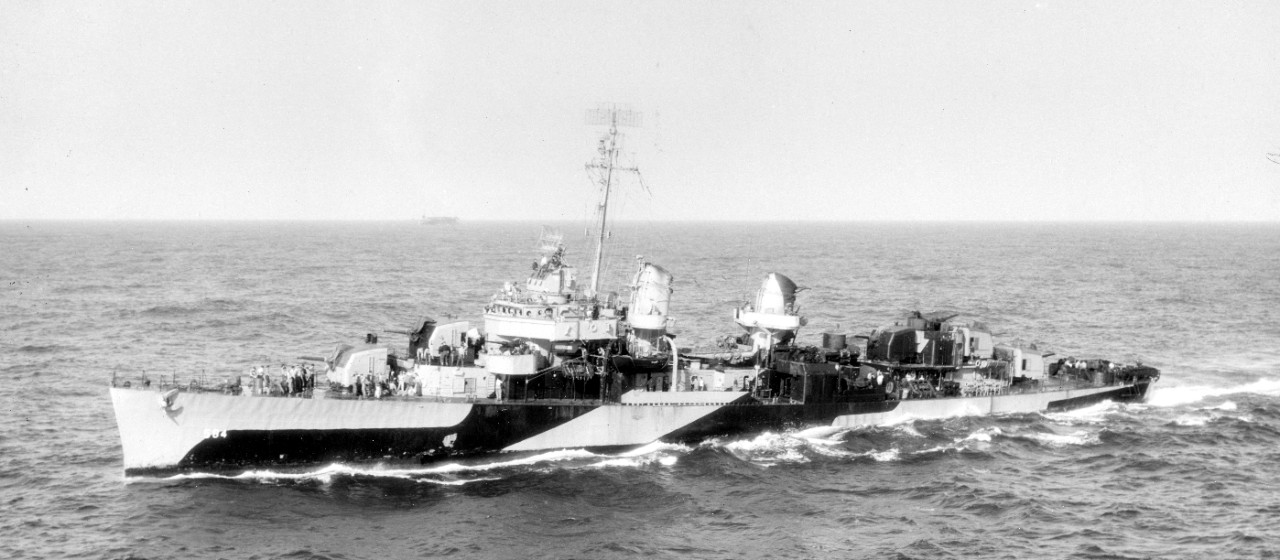
Concluding her yard period on 21 March 1944, Halligan got underway the next day with Capt. Hugh J. Martin, Commander of DesRon 51, temporarily embarked for torpedo tracking and fighter direction exercises. In company with destroyer Evans (DD-552) on the afternoon of 23 March, Halligan departed Pearl Harbor to escort oiler Cimarron (AO-22) to Majuro Atoll in the Marshall Islands. Arriving on the 29th, the ships reported for duty with TF 57. The two destroyers conducted torpedo and gunnery practice together the next day and then returned to Majuro for further orders.
During most of April and May 1944, Halligan operated out of Majuro, conducting blockade patrols in the vicinity of the nearby atolls of Wotje, Erikub, Jaluit, and Mili in the Marshall Islands, searching for submarines and signs of enemy activity ashore. However with the exception of the night of 7 April when the ship observed a bonfire and several smaller lights burning on the western end of Wotje Atoll, Halligan encountered nothing out of the ordinary. Relieved by destroyer Capps (DD-550) on Mili Atoll patrol on 10 May, she returned to Majuro the next morning and began a six-day tender overhaul with Prairie (AD-15).
After completing repairs on 18 May 1944, Halligan in company with Haraden escorted small aircraft carrier Bataan (CVL-29) to Pearl Harbor, arriving at midday on the 22nd. The two destroyers held a maintenance and training period while in Hawaii, which included exercises in radar tracking and gun calibration on 30 May, a practice shore bombardment and other exercises at Kahoolawe Island with destroyers David W. Taylor (DD-551) and Rowe (DD-564) on 1–2 June, and torpedo practice with David W. Taylor on the 3rd.
Halligan and Haraden returned to escort duty on 5 June 1944, screening Natoma Bay (CVE-62), Manila Bay, and Hector (AR-7) to Eniwetok. The convoy arrived on 13 June, and the next day Halligan moored next to Prairie for repairs to her air search radar antenna. On the 16th, the same task unit less Hector departed for Saipan, arriving on station 40 miles offshore on the 19th. Beginning on the morning of 22 June, Natoma Bay began launching Republic P-47 Thunderbolt U.S. Army fighter aircraft, all headed to the newly-secured Aslito Airfield on Saipan. At noon on the 23rd, Halligan went to general quarters when radar picked up a bogie, and several minutes later, four Japanese Mitsubishi A6M Type 0 carrier fighter planes [Zeke] suddenly emerged from the overcast and began dive-bombing Manila Bay. Fortunately the bombs all missed their target and the planes sped away without further incident. Both carriers continued launching Thunderbolts, and with the last of the 74 Army planes dispatched to Saipan on 24 June, the ships returned to Eniwetok, arriving on the afternoon of the 27th. Continuing on for Pearl Harbor on 1 July, the task unit was joined by the oilers Niobrara (AO-72) and Cache (AO-67) that evening. Cache detached on 4 July and the remainder of the task unit reached Hawaii on the 8th.
At Pearl Harbor, Halligan then began a brief period of upkeep and training. From 13–15 July 1944, the destroyer in company with Smalley (DD-565) provided plane guard and submarine screening services for the light aircraft carrier Independence (CVL-22). On 17 July, Halligan served as fleet gunnery and torpedo school ship for a class of 17 student-officers. Over the next several days, the ship completed ASW exercises with Fieberling (DE-640) and torpedo practice with Drayton (DD-366), conducted an experimental shore bombardment practice at Kahoolawe Island, and provided an antisubmarine screen for the light cruiser Columbia (CL-56) as she sortied from Pearl Harbor.
Departing on 31 July 1944, Halligan got underway with the carriers Cowpens (CVL-25) and Independence, providing submarine screening and plane guard services with Rowe (DD-564) and Cushing (DD-797) during aircraft and gunnery exercises off Pearl Harbor. At 0538 the next morning, a Grumman F6F-5 Hellcat (BuNo 58424) splashed during takeoff from Cowpens. Halligan dispatched its boat to the scene and recovered the body of the pilot, Lt. John Collier Maxey Jr., A-V(N), USNR. Exercises continued without further incident, and Halligan returned to port on 3 August. From 4–8 August, she practiced her gunnery and antiaircraft skills again with Enterprise (CV-6), La Prade (DE-409), and Cushing.
Halligan continued with her training activities during the late summer. From 13–15 August 1944, she exercised with Cushing and Independence. She then rendezvoused with Portland (CA-33) to screen for submarines while the cruiser completed a gunnery exercise with Lamberton (DMS-2). She returned to port, and on the 17th and 19th, she once again served as school ship for officers training in torpedoes and gunnery.
During the first week of September, Halligan participated in shore bombardment and amphibious landing exercises in the Maui-Kahoolawe operations area, providing submarine screening and fire support. Then from 8–9 September, the destroyer held a maintenance and repair availability at Pearl Harbor.
Departing on 15 September 1944, Halligan joined TU 33.8.1 screening two task groups of transports en route to Eniwetok. The voyage was uneventful until the morning of 24 September. At 0810, an altercation took place in Halligan’s wardroom pantry, during which StM1c Otis R. Hopson, USNR, stabbed StM1c Kenneth Brown, USNR, in the chest and arms. Brown died at 1645 and was buried at sea the next morning. Following a board of investigation, Hopson was charged with voluntary manslaughter and faced a general court martial on 11 October. He was detached from the ship three days later at Manus in the Admiralty Islands to await his sentencing.
The convoy arrived at Eniwetok on the afternoon of 25 September 1944 and continued on toward Manus on the 28th. Crossing the equator on 2 October, Halligan held a traditional Crossing the Line ceremony during which her trusty shellbacks initiated her slimy pollywogs into the mysteries of the realm of King Neptune. The following afternoon, the convoy arrived at Seeadler Harbor, Manus.
Now assigned to the Seventh Fleet’s TF 79 to support the planned invasion of the Philippines, Halligan put to sea with the Southern Attack Force on 14 October 1944. Arriving at Leyte Gulf at dawn on 20 October, the force’s transports commenced landings near the town of Dulag on the island of Leyte later that morning with little opposition from the Japanese occupying forces. At 1601, a Japanese Nakajima B5N2 Type 97 carrier attack plane [Kate] made a run at the light cruiser Honolulu (CL-48). Halligan and other ships of the group fired at the aircraft but it was able to get away. Honolulu sustained a torpedo hit and listed heavily to port, but the ship survived the encounter.
After anchoring off Catmon Hill that evening, Halligan once again engaged with the ever-present Japanese planes. The next day the American warships covered themselves in a smokescreen to protect from enemy air attack, and overnight on 21–22 October 1944, Halligan fired illuminating projectiles every five minutes for seven straight hours to illuminate any oncoming planes attempting a night attack. At 0605, less than a half hour after the destroyer ceased firing the projectiles, an Aichi D3A1 Type 99 carrier bomber [Val] broke through the smoke screen very close to Halligan. Flying only 50 feet above the water, the plane released two bombs and quickly disappeared into the smoke before Halligan’s gunners could react. Fortunately, the projectiles passed between the destroyer’s stacks, missed the ship, and hit the water 25 yards to port without exploding. At dawn on the 24th, she fought off two more enemy Vals.
On the afternoon of 24 October 1944, Halligan received word to prepare to engage approaching Japanese surface ships in Surigao Strait, the southern entrance to Leyte Gulf. However, Halligan, Haraden, and Twiggs (DD-591) were instead assigned to remain behind in San Pablo Bay to protect the American transports and smaller vessels while TG 77.2 steamed south to take on the Imperial Japanese Navy’s Southern Force. While the three destroyers passed a relatively uneventful night in the bay, the American task group decimated the Japanese convoy, ultimately sinking six of her seven ships.
The situation at San Pablo Bay, however, did not remain peaceful as beginning at dawn on 25 October, Halligan and her fellow DesDiv 101 destroyers faced near constant attack from enemy aircraft. At 0732, Halligan fired at a Mitsubishi G4M1 Type 1 attack plane. Its engine caught fire and the Betty was observed to have crashed after departing the scene. Less than an hour later, the three warships fired on four Japanese Yokosuka P1Y1 Ginga bombers forming to attack the transport ships in the harbor, splashing one Frances.
Meanwhile, the destroyers had received orders to join up with TG 77.2, which, following the overnight battle at Surigao Strait, was en route to protect the eastern entrance of Leyte Gulf and assist TU 77.4.3. This Northern Carrier Group, consisting of six escort carriers and their seven screening ships commanded by Rear Adm. Clifton A. F. Sprague in Fanshaw Bay (CVE-70), was at that time engaged in a desperate struggle against the powerful battleships and cruisers of the much larger Japanese Central Force that had caught the American task unit by complete surprise off the coast of the island of Samar. Valiant actions taken by the task unit’s escort ships as well as a vigorous air defense from TG 77.4’s carrier planes persuaded the Japanese warships to retire, but enemy aircraft continued to pound at Sprague’s retreating task unit. His group ultimately lost two carriers and three escorts, and his remaining vessels save for his flagship sustained considerable damage.
Late on the morning of 25 October 1944, Halligan, Haraden, and Twiggs reached TG 77.2 at the eastern entrance to Leyte Gulf. By that time, the Japanese Central Force had retired to the north and the task group had received orders to replenish their ammunition. The three division-mates detached from the group that afternoon with instructions to rendezvous with TU 77.4.3 and pick up survivors from the morning’s action. However, due to a miscommunication with CTG 77.2, the destroyers proceeded in the wrong direction for an hour before reversing course, and they did not locate any survivors in the dark.
On the afternoon of 26 October 1944, the destroyer trio finally joined the remaining battered escort carriers of TU 77.4.3—Fanshaw Bay, Kalinin Bay (CVE-68), White Plains (CVE-66) and Kitkun Bay (CVE-71)—and their escort Hale (DD-642), which soon detached from the group. With the fresh escorts in place, the task unit set off for Woendi in the Padaido Islands to refuel. While en route at 1400 on the 27th, Halligan made an underwater sound contact and dropped 11 depth charges with inconclusive results. However given the need to maintain a screen for the damaged carriers, there was no time to develop the contact any further, and the destroyer quickly rejoined the formation without regaining the contact.
After reaching Woendi Harbor on 29 October 1944, the task unit refueled and set course for Manus the next morning, arriving at Seeadler Harbor on the afternoon of 1 November. The following day, Halligan’s commanding officer arrested the destroyer’s Supply and Disbursing Officer, Lt. (j.g.) George Hansen, SC-V(G), USNR, and secured all of the ship’s safes and storerooms. Charged with conduct unbecoming an officer, Lt. (j.g.) Hansen was relieved of his duties and resigned his commission “for the good of the service,” departing the ship on 8 November.
At 0855 on the morning of 10 November 1944, a loud blast broke the morning calm at Seeadler Harbor. A massive explosion instantly reduced the ammunition ship Mount Hood (AE-11) to countless bits of shrapnel violently radiating upwards and outwards, piercing anything in their path. The unfortunate ammunition ship had lay anchored 3,000 yards off Halligan’s starboard quarter. Pieces of flying metal punctured Halligan’s No. 2 stack, causing two small tears, but fortunately caused no casualties amongst her crew. Many other vessels in proximity to Mount Hood, however, did not fare as well, with at least 17 ships and numerous smaller craft sustaining damage or destroyed in the incident, and 45 sailors died, with another 327 listed as missing and 371 men injured. Halligan sent a rescue team to assist with the casualties, and they transported three sailors from the attack cargo ship Alhena (AKA-9) back to the destroyer for medical treatment of minor injuries and shock.
Once again in company with Haraden and Twiggs, Halligan steamed from Manus on 12 November 1944 to rendezvous the next morning with TU 79.15.1, a transport convoy led by Cavalier (APA-37) en route to Leyte Gulf. The destroyers escorted the task unit until the evening of the 17th, when they detached and proceeded to Kossol Roads in the Palau Islands, arriving the next afternoon. From 21–28 November, the trio was underway with TU 77.4.6 screening Marcus Island (CVE-77), Petrof Bay (CVE-80), and Savo Island (CVE-78) as the carriers’ planes patrolled east of Leyte to protect friendly shipping. On the morning of 30 November, all ships located at Kossol Roads received orders to put to sea in anticipation of a Japanese air raid. Halligan and her fellow DesDiv 101 destroyers sortied with TU 77.12.7 and headed for Leyte Gulf, but the ships were soon recalled to Kossol Roads and returned there on the morning of 2 December.
As the rest of the assembled battle force prepared for the upcoming amphibious landing operation on the Philippine island of Mindoro, Halligan departed Kossol Roads independently on the evening of 5 December. Upon her arrival at Manus on the 8th, the destroyer had repairs made to her fire control system that were completed that evening. On 14–15 December, she provided submarine screening and plane guard services with Helm (DD-388), Bagley (DD-386), and Gridley (DD-380) for Saginaw Bay (CVE-82) and Hoggatt Bay (CVE-75) as the escort carriers conducted pilot qualification flights in the Bismarck Sea. From 16–20 December, Halligan joined TG 77.4 for flight operations in the Solomon Sea off Lae, New Guinea. During this voyage on 18 December, the destroyer rescued Ens. Thomas E. Marshall, (A1), USNR, whose General Motors FM-2 Wildcat (BuNo 57002) went overboard from Petrof Bay during an attempted landing wave-off. Two days later, two Wildcats (BuNo 73644 and BuNo 73771) flying from Salamaua (CVE-96) collided during simulated air combat, Ens. J. W. Cook A-V(N), USNR, being lost in BuNo 73771 and Lt. (j.g.) James T. Isley managing to reach an airfield ashore with a damaged wing. Halligan conducted a search in the area of the accident, recovering pieces of one of the Wildcats but no survivors. She returned to Seeadler Harbor that afternoon.
Sailing with elements of TG 77.4 on 27 December 1944, Halligan set course for Kossol Roads, arriving on the 30th. Departing on New Year’s Day, the destroyer served as a screening unit for TG 77.2 and TG 77.4 en route to Lingayen Gulf to take part in the invasion of Luzon. While transiting through the Philippine Islands on 4 January 1945, the combined task groups faced many enemy attacks from the air. At 1717 that evening in the Sulu Sea, a Japanese kamikaze struck Ommaney Bay (CVE-79), seriously damaging the carrier and starting a large fire. Surviving crew abandoned ship, and at 1958, the destroyer Burns (DD-588) torpedoed and scuttled the ill-fated vessel.
The following day as the task force traveled up the western coast of Luzon, the American ships continued to be on alert for potential Japanese air attacks. Late in the afternoon of 5 January 1945, Halligan splashed a Nakajima A6M3 Type 0 Model 32 carrier fighter [Hamp] and other task force ships successfully shot down additional enemy planes, but several Japanese pilots managed to evade the force’s antiaircraft defenses. Manila Bay, Savo Island, escort ship Stafford (DE-411), and the heavy cruiser HMAS Australia all sustained varying degrees of damage from hits by kamikazes. At 1814, Halligan received orders to assist Stafford, seriously damaged when a suicider struck the starboard side of the ship at the waterline, flooding both the after engine room and after fire room. While her repair crew assessed the damage to the stricken vessel, Halligan embarked eight injured men and a pharmacist mate from Stafford. Emergency repairs stemmed the flooding, and within an hour, Stafford was ready to proceed on one engine at a maximum speed of 10 knots, with Halligan and Ulvert M. Moore (DE-442) escorting.
As the three warships slowly steamed ahead to rejoin the task force early on the morning of 6 January 1945, fleet tug Quapaw (ATF-110) joined the group and attempted to take Stafford under tow. Although the hawser quickly parted and she was unable to tow the damaged escort ship, the tug stayed with the group. Meanwhile unidentified planes circled the ships, remaining nearby for the rest of the night but only attacking once without causing any further damage. At 1030, Halligan held a burial at sea for WT3c Victor Masi, USNR, a Stafford sailor who had succumbed to his injuries earlier that morning.
Relieved of her escort duty with Stafford by destroyer Ralph Talbot (DD-390) at 1837 on 6 January 1945, Halligan caught up to the carriers of TU 77.4.2 one hour later. Steaming in the South China Sea west of Luzon, carrier aircraft commenced bombing and strafing runs in the San Fabian area of the Lingayen Gulf on the morning of the 7th. At 1135, Halligan rescued Lt. Albert Miller Jr., USNR, ARM1c Albert A. Alvarez, and AMM3c J. M. Kerby, who were afloat in a raft after their General Motors TBM-1C Avenger (BuNo 73350) splashed on takeoff from Manila Bay.
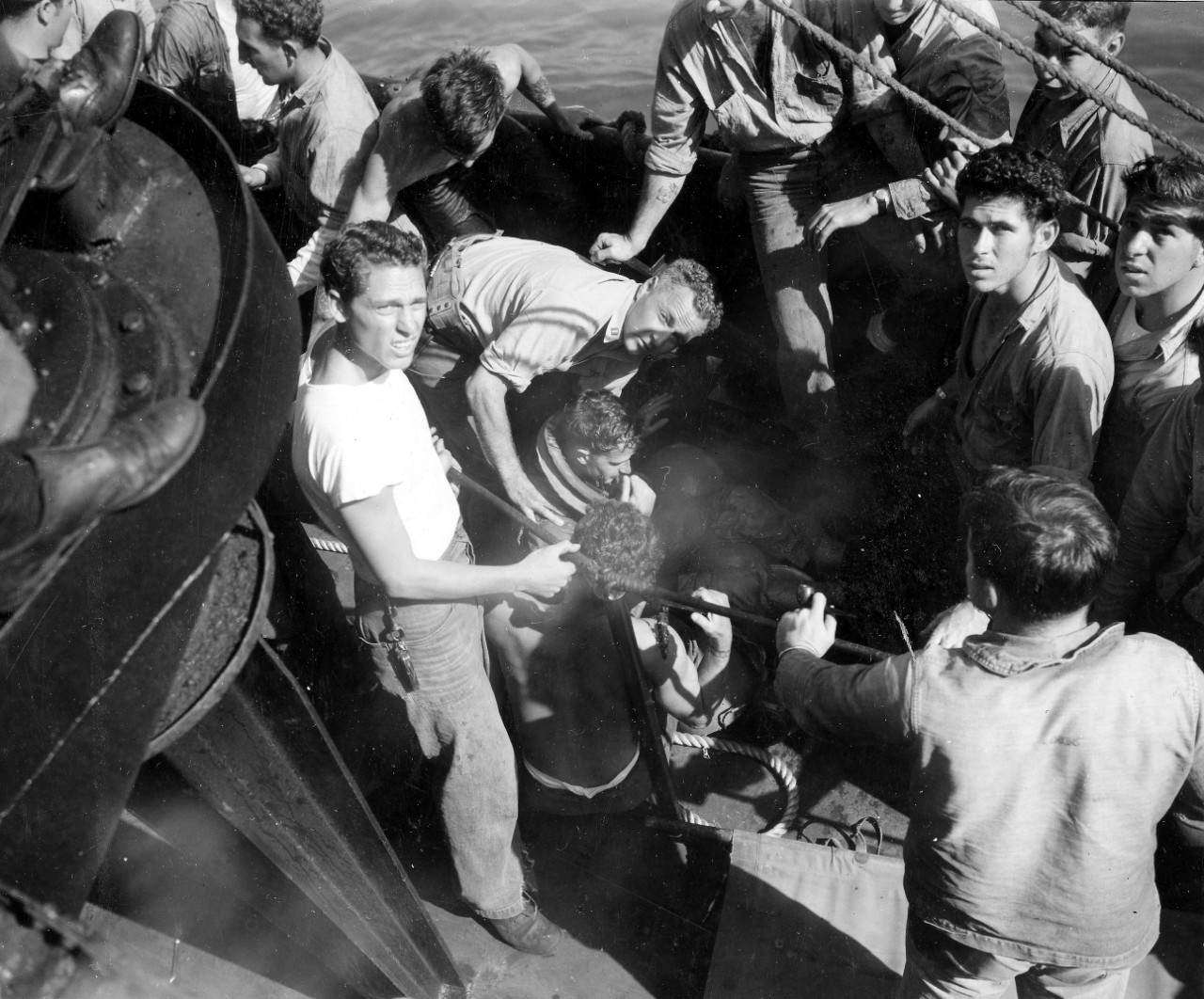
As Allied troops began landings on Luzon on the morning of 9 January 1945, supporting flight operations continued. At 1144, Halligan picked up Lt. (j.g.) Robert J. Currier, USNR, who made a water landing in his FM-2 Wildcat (BuNo 56722) after the plane’s tailhook would not extend. On the afternoon of the 12th, another Avenger (BuNo 68224) from Manila Bay splashed on attempted takeoff 5,000 yards ahead of Halligan. The destroyer sprang into action and saved the pilot, Ens. William W. Hegg, USNR, as well as crewman AMM3c Richard M. Kidd. After searching unsuccessfully for an additional half hour for the third airman, ARM3c George K. Mann, Halligan resumed her station in the formation.
Over the next week, the carriers’ aircraft continued with combat air patrol and tactical and strategic bombing runs while the destroyers and escort ships patrolled for enemy submarines and rescued downed flight crews. In the early morning hours of 18 January 1945, the task unit headed south, with Halligan screening a group of carriers to the island of Mindoro. On the morning of 21 January, Halligan put in to Mangarin Bay, Mindoro, and refueled from the oiler Pecos (AO-65). Later that afternoon, she put to sea again with TU 78.3.19—fellow DesDiv 101 ships Hall, Paul Hamilton (DD-590), and Twiggs—and headed for Leyte Gulf. The destroyers spent the night of 22–23 January at anchor in San Pedro Bay and then continued on to Ulithi, arriving on the 25th.
Following upkeep and replenishment at Ulithi, Halligan got underway again on 9 February 1945 to complete training for the upcoming action at Iwo Jima beginning with an antiaircraft exercise with her task unit. The next day, the destroyer screened the heavy vessels of TU 54.9.1 as they held antiaircraft practice, and upon completion of the exercise, the group sailed for the Saipan-Tinian training area in the Marianas Islands. On 12 February, Halligan participated in a simulated shore bombardment at Tinian. She put in to Saipan Harbor that afternoon to exchange ammunition with Mannert L. Abele (DD-733) and then rendezvoused once again with TU 54.9.1. As troops conducted a practice landing exercise on shore, Halligan took part in another simulated shore bombardment on the 13th. The next morning, the task unit rendezvoused with three task groups to form TG 52.19, and this combined unit set course for Iwo Jima to take part in the planned invasion of the Japanese island.
The task group arrived at Iwo Jima before dawn on 16 February 1945, and the ships dispersed to assume their assigned stations. Halligan’s role in the first three days of pre-landing bombardment of the island was to screen the gunfire support vessels. On the morning of the 16th, she spotted a type 93 mod. 3 Japanese moored mine floating 1,000 yards to port. Unable to destroy it with her 40-millimeter guns, the destroyer called in submarine chaser PC-800 to handle the situation. At 0515 the next morning, Halligan left the formation to rendezvous with destroyer Newcomb (DD-586). Steaming 25 miles north of Iwo Jima at 0635, Halligan spotted a bogie on radar. Soon a Betty appeared 3,500 yards distant from the ship’s port bow, low to the water, seemingly poised for a torpedo run on the vessel. Halligan unleashed her full firepower on the enemy plane, setting it on fire. As the destroyer maneuvered to avoid the oncoming aircraft, the plane dropped a bomb or torpedo that missed her 100 yards to port and failed to detonate. The Betty crashed and exploded 4,000 yards abeam to port, and Halligan then joined Newcomb to proceed to their assignment as lifeguards for planes attacking Haha Jima and Chichi Jima.
After returning to the vicinity of Iwo Jima late on the 18th, at 0600 on 19 February 1945, Halligan took her position 2,750 yards off Mt. Suribachi. Fifteen minutes later, the larger vessels of the task force began shelling the island. Halligan commenced firing at 0825, and at 0900, the first U.S. Marines landed on the beach. Over the course of the day’s firing in support of the Fifth Marine Division on the Red and Green beaches, the destroyer’s guns took out a building and a camouflaged gun on the island. After being relieved by Thomas E. Fraser (DM-24) that afternoon, Halligan proceeded to a position southwest of Iwo Jima and screened the aircraft carriers around the island for the rest of the month and into early March. On the morning of 3 March, Halligan rescued Lt. (j.g.) Claude D. Tate, USNR, whose FM-2 (BuNo 56866) plunged over the side of Natoma Bay while taking off.
On 11 March 1945, Halligan retired from the Iwo Jima area with TG 51.26. The group arrived at Ulithi on the 14th, and the destroyer commenced a week of maintenance and upkeep at the side of tender Cascade (AD-16). With repairs completed on the 19th, Halligan loaded ammunition the following day in preparation for her next operation. Among the personnel changes made at Ulithi, Lt. Cmdr. Edward T. Grace assumed duties as Halligan’s commanding officer on the 20th.
Halligan sortied from Ulithi as part of TF 54 on 21 March 1945. The battleships, cruisers, and destroyers in this task force, the Gunfire and Covering Force, were to support the large-scale amphibious offensive attack planned for the Japanese island of Okinawa scheduled to begin on 1 April. TU 54.1.2 arrived west of Kuba Island, part of the Kerama Islands off the southwest coast of Okinawa, on 25 March. The allied objective was to take control of the Keramas as a preliminary to the assault upon Okinawa. At 1500 on the 25th, Halligan detached from the formation to serve as an escort, along with Hall and Willmarth (DE-638), for the battleship Colorado (BB-45). At dawn on the morning of the 26th, the warships moved into position south of the Keramas to provide gunfire support for the minesweeping and underwater demolition units assigned to clear the area, which had been heavily mined in irregular patterns by the Japanese.
At 1600 on 26 March 1945, Halligan detached from the Colorado unit to undertake night patrol duty between Okinawa and the Kerama Islands, with instructions to take care to remain in waters that the minesweepers, still actively destroying mines nearby, had already cleared. Steaming roughly midway between Okinawa and the island of Tokashiki at approximately 1830, the destroyer suddenly erupted in a powerful explosion, shrouding her in a thick cloud of smoke, oil, steam, fire, and debris that shot at least 200 feet skyward. When the air cleared, witnesses in nearby ships could see Halligan still underway, albeit erratically, but everything forward of her No. 1 stack including the bridge had been obliterated. Cmdr. Timothy F. Donohue, Commander of Mine Squadron 4, observing in minesweeper Impeccable (AM-320) located five miles to the southeast, witnessed the blast and noted in his action report, “It was a tremendous explosion and it is surprising that any of the ship remained afloat.” Donahue also stated that at the time of the explosion, Halligan was operating in uncleared waters, further noting that on the following day, minesweepers destroyed mines within 500 yards of the disaster site. It was therefore likely that Halligan had steamed directly into an unseen mine that then caused her two forward ammunition magazines to detonate.
On board the destroyer, Ens. Bert Jameyson, USNR, the assistant engineering officer, and Ens. Richard L. Gardner, USNR, assistant first lieutenant, soon discovered that they were Halligan’s only surviving officers. The two ensigns began to round up the wounded men, among whom included Ens. Jameyson, who suffered facial burns and a broken arm in the explosion. The junior officers also assessed the considerable damage to the destroyer, and noting that she appeared to be settling forward, they decided that it would be best to abandon ship. Several nearby vessels, including PC-584, LSM(R)-194, PC-1128 and LSM(R)-195, all rushed to Halligan’s aid. Within an hour of the incident, the ship had been thoroughly searched and all survivors had been offloaded from the hulk, with several more plucked from the water. All told, 167 sailors survived the disaster, just over half of Halligan’s complement of 327 officers and enlisted men.
Ens. Gardner later particularly commended CPhM Patrick Jenkins, the senior survivor of the Halligan’s medical department, who, though wounded, “directed the evacuation of many of the injured…and tended to the casualties with exceptional ability” after they had been rescued, pursuing that task “for many hours before a medical officer was summoned.” M3c Nicholas Charin assisted two men injured in the explosion, then came across a shipmate whose legs had been pinned by heavy debris. Despite the “extremely hazardous conditions due to the settling of the ship and the danger of fire from large amounts of oil,” Charin employed an acetylene torch to cut loose the injured sailor, eliminating the necessity of amputating the man’s legs to remove him from the doomed destroyer. Jenkins and Charin each received the Navy and Marine Corps Medal for their heroism.
As the rescue vessels departed in the darkness, the battered destroyer appeared to be slowly sinking. The next day however, LSM(R)-194 and U.S. planes spotted the remains of Halligan’s hull washed up on a reef 50 feet from the shore on the southeast coast of Tokashiki, nearly 12 miles from the site of the mining. On 28 March 1945, a party of officers from Amphibious Group (PhibGru) 7 and fleet tug Yuma (ATF-94) went to the hulk to search for any additional survivors and to evaluate its salvage potential.
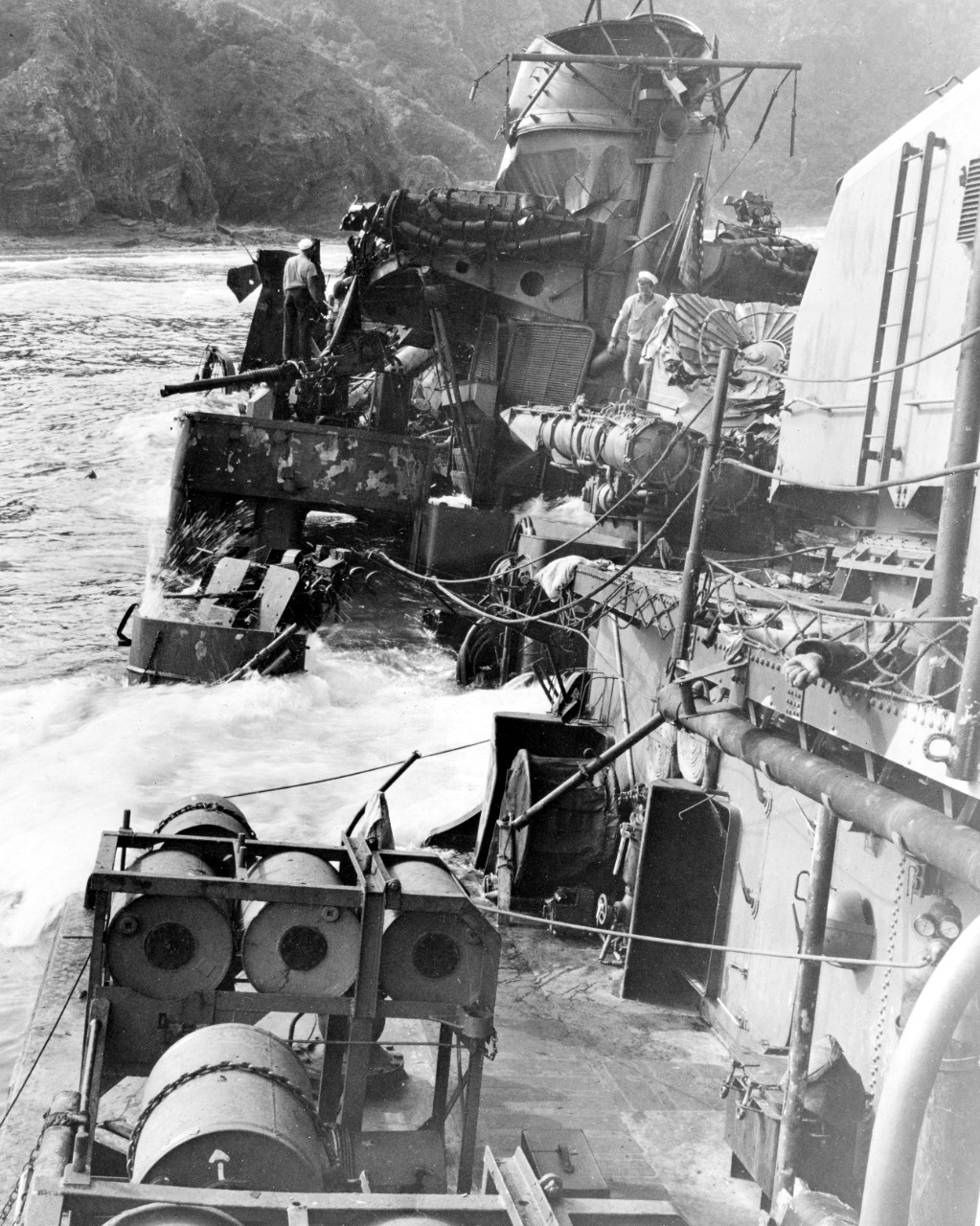
In the time since she had been abandoned, the severely damaged wreck had been further ravaged by the surf and appeared to have been shot at by Japanese shore batteries at least twice. After examination, the crew determined that no more than 15 percent of equipment and materiel could be salvaged. A second inspection of the hulk in June 1945 concluded that nothing of value remained on the ship and that no further action need be taken with her remains.
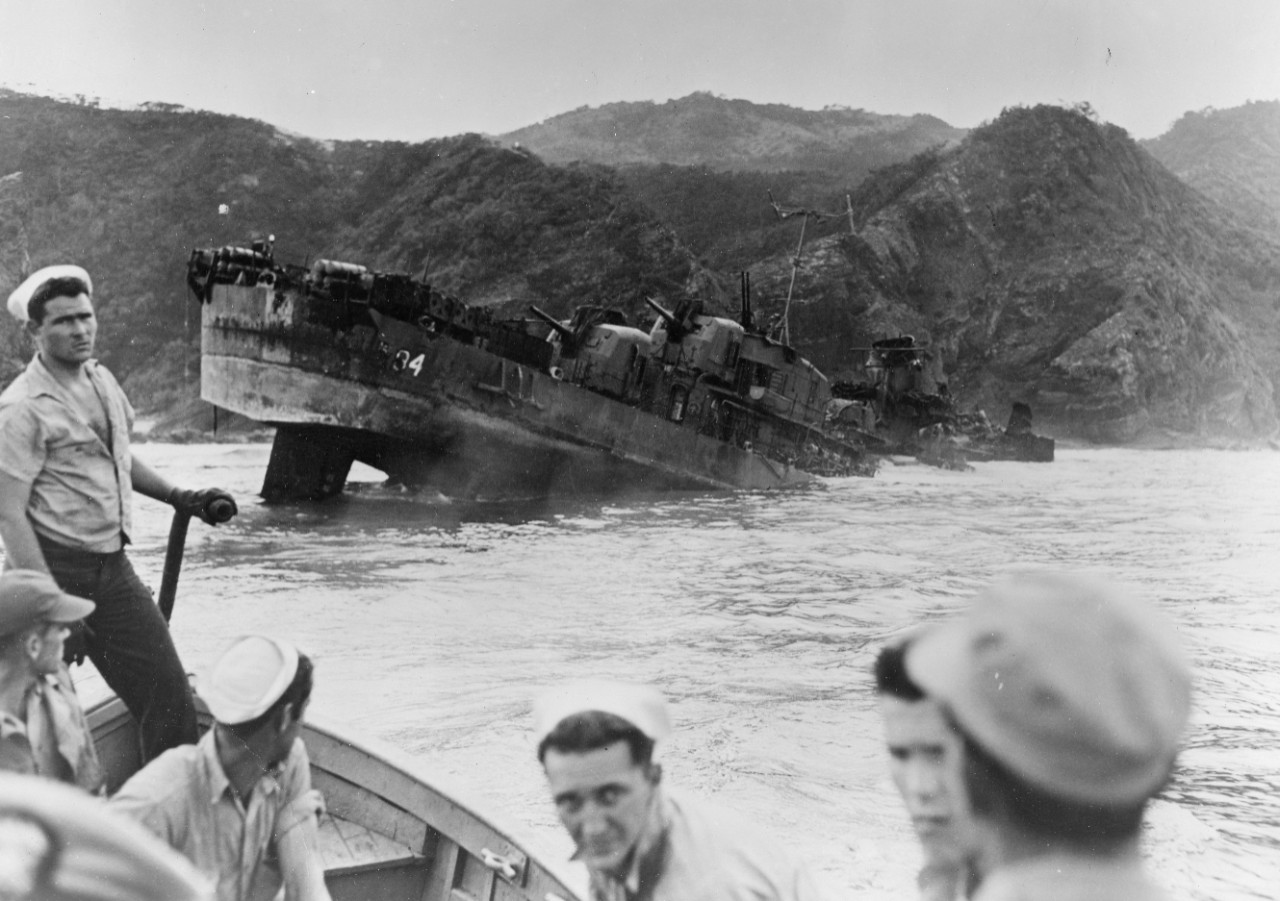
Halligan was stricken from the Navy List on 28 April 1945. Her hulk was donated to the government of the Ryukyu Islands in 1957.
Halligan was awarded six battle stars for her World War II service.
| Commanding Officers | Dates of Command |
| Cmdr. Clarence E. Cortner | 19 August 1943–20 March 1945 |
| Lt. Cmdr. Edward T. Grace | 20 March 1945–26 March 1945 |
Stephanie Harry
14 February 2019


